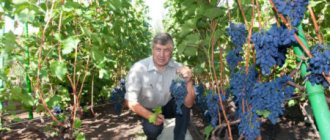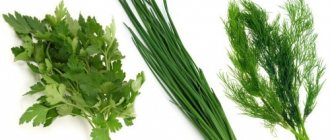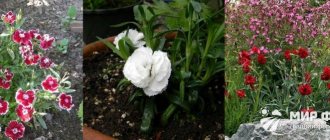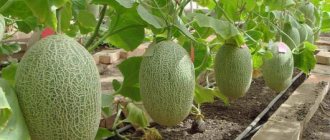Self-grown grapes will always find a place on your kitchen table - either in the form of sweet, large and tasty berries, or in the form of homemade wine. In addition, surplus grapes can always be sold or gifted to your acquaintances and friends. But how to achieve a bountiful harvest of this crop in the middle zone, where there may be a lack of light and heat? The solution to this problem is to grow grapes in a greenhouse.
Growing grapes in a greenhouse
Pros of growing in a greenhouse
Cultivating a crop in protected soil has many advantages. When growing in a greenhouse, you don’t have to worry that the grapes won’t have time to ripen before the cold weather sets in, because the climate in the greenhouse can be controlled independently. In addition, even in the south, many winegrowers prefer to grow berries indoors, because this way they can get the harvest much earlier than expected. This is especially true for those farmers who are engaged in entrepreneurial activities and grow grapes for sale. The advantages of greenhouse cultivation also include:
- No problems with harmful insects and diseases - any living creatures rarely enter the greenhouse, including wasps, which often spoil the berries. Diseases such as mildew and oidium appear extremely rarely in greenhouses.
- Plants are protected from adverse weather conditions, be it rain, wind or sun. Grapes grow and develop in static climatic conditions.
- The growing technology is simple. Plant care is convenient. There is no need to additionally treat the bushes with fungicides and insecticides.
- The berries do not crack from precipitation, and the brushes do not fall apart from windy gusts. This allows the gardener to harvest a full harvest in full.
- The taste of the fruit remains at the same level, in no way inferior to ground grapes.
When to open a plant in spring
It is recommended to open the vine under the following conditions:
- complete melting of snow on the site;
- disappearance of puddles and drying of the top soil layer;
- establishing a stable average daily temperature from -5°C to 0°C.
It is not advisable to keep grapes under winter protection for too long, but releasing them too early is also not recommended. In both cases, the outcome is the same - loss of the crop or the plants themselves. This is due to the death of the ovaries under the film from the sun and night frosts. If we focus on weather conditions based on the territorial factor, then the timing of crop opening is as follows:
- central Russia, the Moscow region and the Volga region - mid-April (with early spring warming) and the end of May (in the case of late spring);
- southern regions - from March 20 to the end of April;
- Far East, Urals, North - in early May, but with the construction of greenhouse protection (in case of a sudden cold snap at night).
Variety selection
Almost all varieties are suitable for greenhouse cultivation, but the best productivity is shown by those that have early ripening periods. For the first time, it is preferable to select cold-resistant, highly immune, shade-tolerant varieties that are guaranteed to produce good offspring. Considering the size and height of the greenhouse, it is recommended to give priority to medium-sized and weakly branched varieties.
Table of varieties most suitable for greenhouses:
| Variety name | Growing season | a brief description of |
| Laura | 110-115 days | High yield. Large berries. Great taste. The mass of the bunch is up to 2.5 kilograms. |
| Song (White Miracle) | 110-115 days | The berries are large, with a large proportion of sugar. The color of the fruit is light green. |
| Greenhouse black | 115-125 days | Self-pollinating variety. The taste of the berries is mediocre. Low resistance to fungal diseases. |
| Memory of Dombkowska | 155 days | High-yielding. Has high immunity. Frost-resistant. |
| Arcadia | 115-125 days | Productivity is above average. Cold-resistant down to -21 degrees. Not susceptible to mildew. Compatible with many rootstocks. |
| Moscow sustainable | 130-140 days | Frost-resistant variety (up to -25 degrees). Possesses enviable health. The berries taste good. |
| Russian Korinka | 110-120 days | Vigorous bush. Resistant to mildew, often affected by oidium. Tolerates frosts down to -28 degrees. |
Greenhouse requirements
In a properly equipped greenhouse, all phases of the growing season of a grape plant pass much faster than in open ground, on average by two weeks. Grapes can be grown in unheated and heated greenhouses. In the first case, the harvest can be obtained 3 weeks earlier than usual, in the second - a month.
What should a greenhouse be like:
- The height of the greenhouse structure must be at least 2.5 meters. For private farms, a small room is suitable, while grapes grown for sale require a lot of space.
- The frame must stand on a strong and deep foundation, which will reliably protect the greenhouse soil from soil pests and weeds. You can build a shallow strip concrete foundation.
- A polycarbonate greenhouse is optimal for growing grapes. This material transmits light well and has good thermal insulation. For unheated rooms, film or glass are suitable.
- There should be vents in the upper part for complete ventilation of the room;
- If a heat-loving variety is cultivated, then the greenhouse must be heated using a fan heater or heating radiator. Phytolamps are used for additional lighting.
- In winter, walls (film, glass) must be removed so that the ground can “breathe” oxygen and be saturated with moisture from the snow.
Preparatory work
When growing grapes in protected soil, you need to know one nuance: a grape seedling can be planted outside the greenhouse, but the trunk and vines themselves must be inside it. Therefore, you need to make a hole in the lower part of the greenhouse wall and push the stem into the greenhouse zone, and the part of the plant that remains outside can be covered with earth or grass mulch.
The soil should be thoroughly warmed up, the approximate temperature is 10 degrees Celsius.
To do this, the greenhouse is heated artificially. The soil should be loose, soft, slightly acidic. The required substrate is made up of different parts of peat (3 parts), loamy soil (7 parts), sand (3 parts), crushed chalk or lime (50 grams per bucket of soil), mineral fertilizers (50 grams of nitrogen, 30 grams of superphosphate, 15 grams potassium). The prepared soil mixture is poured into deep holes, into which young seedlings will subsequently be planted (if planting is carried out in a greenhouse). Advice! It is better to carry out preparatory work in the fall.
Organic matter is added at this time so that by spring the soil will completely absorb all the nutrients from it. In the room you need to install trellises in advance, stretch the wire on which the garter will be made. The wire must be placed at a distance of 20 centimeters from the glass to avoid burns to the vine. The distance between the wire rows should be about 20 centimeters.
Ventilation
The greenhouse should have several doors to provide a natural ventilation system.
To save time, it is better to install a special hood, which will completely replace the air in the room in a few minutes.
Ventilation is done for the following purposes:
- Preventing stagnation of air masses provokes the accumulation of harmful bacteria, which are causative agents of serious diseases.
- Control of air humidity - excess moisture is a trigger for the activation of bacteria that cause rotting of the vine.
- Release of insects that pollinate grapes.
When ventilating, it is important to prevent a sharp drop in air temperature, which will stress the grapes and slow down their growing season.
DIY trellises
A grape bush, which is characterized by strong growth and branching, needs to be tied to a support. Typically, a trellis is used as a support - several pillars driven along the bed, between which layers of thread are stretched to tie up the vines. In the greenhouse it is permissible to use T-shaped, single-plane and horizontal trellises, which you can make yourself.
Vertical single-plane trellis
The essence of such a trellis is that along the growth of grape bushes, at an equal distance from each other, tall metal pipes or wooden stakes are driven into the ground, between which a wire or strong thread is stretched. The whip is tied to the wire in a horizontal position. The next lash, which is located above the previous one, will be tied in the same way to the top layer of wire, etc.
The distance between the thread wires is 35-40 centimeters - this is the optimal value so that each lash can be well ventilated and illuminated by the sun. A gap of one meter is left between the stakes (or pipes). If you install them a little wider, the thread layer will sag and the branches will fall or break.
Advice!
If the plant is vigorous, then you can equip the cornice with a trellis and plant the grapes on the roof. This solution will increase the usable area of the greenhouse.
Horizontal trellis
The design of such support devices is somewhat different from vertical ones. T-shaped or simply vertical posts are installed along the row, over which wire is pulled along and across the greenhouse. The result is something like a grid or lattice with cell sizes of 30*40 centimeters. The vines are allowed to grow along this lattice (the same method is used in vertical gardening). And although the design turns out to be bulky, it still makes harvesting easier, since during ripening the bunches seem to hang from the ceiling and can be simply removed from the bush.
Removing winter shelter
The timing and technique of removing the cover depends on the characteristics of the regional climate. If the spring weather is unstable, the bushes are opened gradually. As soon as the temperature reaches above zero, holes are made in the covering material for ventilation. When a green cone appears, the shelter is removed.
Swollen buds are not a reason to remove the cover. A clear signal is the appearance of shoots on the vine.
If bushes grow in lowlands or trenches, make narrow grooves to drain water. If you don’t dig them, you will have to scoop up water from under the bushes, otherwise the roots will rot.
When and how to open a grape bush in early spring, you can see in the video below:
Purchasing seedlings
Both self-rooted and grafted seedlings are suitable for greenhouse cultivation. But no matter what pedigree the plant has, it must have a healthy and, most importantly, strong root system. The more roots, the faster and better the seedling will take root. If you cut off part of the root, the cut area should be white and moist. Dry, spotted, deformed roots will indicate that the plant is at the stage of death.
The trunk should be smooth, clean, and brown in color. If you slightly move the wood fibers apart, you can see a moist greenish area underneath, indicating the youth and health of the seedling. There should be no husks on the kidneys.
Which seedlings are not advisable to buy:
- if the root system is of an open type, that is, it is not in a moist substrate. In the air, the roots quickly dry out, deteriorate, and die;
- if there is foliage on autumn seedlings. The foliage takes over the strength of the plant, which thus will not survive until spring.
- if at least one bush with signs of disease is noticed among the seedlings sold. Most likely, most of the neighboring seedlings have already become infected.
Trimming
Grapes are very heat-loving, so the vine often freezes even under cover. In spring, two types of pruning are carried out:
- Sanitary. They start working on it right away, removing the cover. Damaged and dead shoots are found and immediately cut off.
- Formative. After sanitary pruning, the formation of the bush begins. This trimming is aimed at adjusting the length of the cordons and sleeves.
In order for the cuts to heal faster, they are made even, smooth, and neat. When cutting old branches into a ring, the stump should be small - no more than 1 cm in height.
Cuts are made on the inside of the bush. 4 buds should be left on the branches, 12-14 on the fruit shoots. Be sure to remove all root shoots so that they do not draw on the nutrients and strength of the plant.
Proper pruning is the key to a high yield, proper development of the vine and good taste of the berries.
Planting grape seedlings
You can plant annual seedlings or rooted cuttings in early spring, when the greenhouse air and soil have warmed up sufficiently. It is necessary to leave a space of 30-40 centimeters from the wall of the greenhouse to the place where the seedlings are planted.
Planting grapes in stages:
- For seedlings, separate deep holes measuring 50*50 centimeters are dug. Depth – 70 centimeters. The distance between the pits is 50-70 centimeters.
- The bottom of the pit is drained with broken bricks, crushed stone, and expanded clay. The drainage layer is 20-25 centimeters.
- Garden soil mixed with humus, minerals, sand (or peat), and ash is poured on top. The layer is compacted.
- A thick pipe for watering is stuck at the edge of the hole. Its height above the ground should remain at 10 centimeters.
- A small mound is placed at the bottom in the center, on which the seedling is placed in a vertical position. The roots are straightened along the mound so that they look exclusively down.
- The soil is backfilled.
- The soil is compacted from above and watered.
Note!
After the pits for the seedlings have been prepared, it is necessary to install trellises, and only then plant them.
Care
Caring for young and then fruit-bearing grapes comes down to systematic watering, formation of shoots, and control of the microclimate. The environment should be comfortable for the crop - the growth of the grape bush will depend on the temperature, amount of sunlight and looseness of the soil.
Features of watering
Greenhouse grapes are watered less often than ground grapes, since the moisture in the greenhouse remains in the soil longer. For the first time, the bush is watered immediately after planting. Then, as soon as it is well rooted, watering is carried out once every 7-10 days, as the top layer of soil dries. During the period of flowering and fruit ripening, the plant requires less moisture. From early July to mid-August, the plant is watered once every two weeks.
Important!
Good ventilation is important for grapes, as they do not tolerate waterlogging.
Temperature
For grapes growing in protected soil, it is important to maintain a suitable temperature. At the time of planting, the temperature in the greenhouse should be an average of +10 degrees. Then the temperature is gradually increased, reaching +24 degrees by the time the buds open. At night, the plant needs +16-18 degrees. When fruit ovaries appear and the crop begins to ripen, the temperature can rise to +30 degrees - this is the optimal indicator for a grape plant.
By controlling the microclimate of the room, it is important to prevent stuffiness, the accumulation of water condensation on the leaves and stems, and the appearance of an earthen crust. During hot days, it is better to shade the greenhouse with a protective awning, otherwise the berries will begin to wither before they have time to ripen.
Note!
The temperature value depends primarily on the grape variety.
Trimming Features
Grapes can be grown along the eaves of the roof. Then it is better to lead the plant in one stem, and pinch the second, spare one. If the greenhouse is not too high, then the grapes can be placed along the wall, forming them in the form of a multi-armed cordon. The essence of pruning greenhouse grapes is that it will remove all the extra shoots that grow during the season, which in a limited space quickly thicken the bush and cast a shadow on the fruits.
In cases where other crops grow next to a grape bush, it is given a standard form. Standard grapes can even be grown in a pot. The plant produces few clusters, but they are of high quality and very good taste.
Formation begins immediately after planting the seedling. Initially, the trunk is severely pruned, and in subsequent years all regrown shoots are shortened by half, cutting off all unripe green areas. To prevent side shoots from growing too quickly, they are pinched in the summer and removed during autumn pruning. The height of the trunk can be up to one meter. Higher up the growth of lateral branches begins. The crown is formed in such a way that up to two buds remain on each shoot during autumn pruning. All side stepsons are completely removed. Gradually, the main short strong branches will form on the bush. In summer, stems will grow from these branches, which are trimmed as soon as they reach 40 cm in length.
To obtain larger berries and voluminous bunches, it is necessary to free the shoots from excess fruit ovaries, otherwise there will be a lot of clusters, but they will grow small and loose. Removing small fruits, weak branches, dried and yellowed leaves will help prevent overload.
Help with pollination
Self-pollinating grape varieties, that is, those whose flowers have organs of both sexes, are optimally suited for the greenhouse. This approach is due to the fact that pollinating bees rarely enter the greenhouse, and therefore pollination may not occur, and therefore there will be no harvest. If you cultivate a bee-pollinated variety, you will have to carry out pollination yourself. When the flowers are fully open, you need to tap the branches or flowers so that the pollen from the male flowers falls onto the female ones. To ensure efficiency, a fan is installed in the greenhouse to spread pollen by the wind.
Top dressing
In the first year after planting, grapes do not need fertilizing. But this is provided that the land was generously fertilized when the beds were planted. Otherwise, the crop needs fourfold application of fertilizers:
- In the spring. Organic matter in the form of ammonium nitrate or urea, potassium salt, and superphosphate are added into trenches 25 centimeters deep dug next to the bush. The share of nitrogen fertilizers at this stage should be 45%, the share of potassium fertilizers – 25%, the share of phosphorus fertilizers – 30%.
- Two weeks before flowering. This time the land is supplied with organic matter (diluted mullein, compost, chicken droppings), 20 grams of potassium sulfate and 25 grams of superphosphate diluted in water.
- The appearance of berries. Carry out foliar feeding with microelements.
- Ripening of berries. The share of phosphorus and potassium fertilizers is doubled. Nitrogen is completely excluded. Wood ash can replace potassium at this stage.
Shelter for the winter
After harvesting, final watering is carried out at the end of September. Moisture will nourish the roots in winter. The vines are removed from the trellises and dug trenches are laid - this will provide the wood with warmth and prevent frostbite. The top of the shoots is covered with spruce branches, straw, dry grass, and sawdust. You can spray the bushes with insecticides and fungicides in advance to prevent the disease from occurring.
It is better if the walls and roof of the greenhouse are removed. In this case, the frame must be disassembled so that the snow creates a reliable protective layer for the grape vines.
By the way!
For the winter, grapes can be covered with non-woven material, for example, roofing felt, agrofibre.
Introduction
Unfavorable climatic conditions and invasions of parasitic insects make it impossible to grow varietal grapes in most regions.
But this fact does not prevent residents of mid-latitudes from feasting on sweet, juicy fruits, proving to the southern region the cunning and dexterity of agricultural technology.
Greenhouses come to the aid of gardeners, which retain heat, transmit sunlight and retain nutrient moisture. It is enough just to control the process and apply fertilizers in order to have a harvest in 3-4 months.
Problems with fruiting
Often a gardener is faced with the problem of fruiting - the grapes produce a very meager harvest, and the fruits are small and not sweet. Most often, the problem lies in incorrect agricultural technology.
Why grapes don’t bear fruit in a greenhouse:
- there are not enough microelements - if fertilizing is not done in a timely manner, the soil is quickly depleted and ceases to fully nourish the plant. If the grapes do not have enough zinc, manganese, boron and other chemical elements, their development will slow down, flowering and fruiting will be weak;
- excess nitrogen - it is important to remember that applying nitrogen-containing fertilizers is advisable only at the first stage of the growing season. During flowering and ripening of berries, an excessive dose of nitrogen can provoke the growth of shoots and leaves, but not fruits;
- flaws in pruning - infrequent or incorrect pruning leads to thickening of the crown, peas, and overloading of shoots with fruits.
Table of step-by-step agricultural activities by month
Spring work is carried out in a certain sequence. The timing and subtleties of agrotechnical measures are adjusted taking into account the characteristics of the local climate.
Spring work calendar:
| Month | List of works |
| March |
|
| April |
|
| May |
|
Rules for growing greenhouse grapes in the Moscow region
The weather in the central region of the country is changeable. Frequent temperature changes, precipitation, cold snaps, days of heat - all this affects the growth of grapes and their productivity. Therefore, in the Moscow region the crop is also grown in greenhouses.
Basic principles of cultivation:
- It is recommended to choose early, medium-growing grape varieties such as Kishmish (seedless);
- It is better to use a wall-mounted version of the greenhouse, that is, one wall is replaced by a house wall, which adds warmth to the greenhouse space. The open parts of the greenhouse should face the south and southwest sides;
- For irrigation, it is preferable to use a drip irrigation system;
- since the soil is often too acidic, when making up a soil mixture for a greenhouse, chalk powder is added to the soil (loam), sand, peat;
- seedlings are planted in the greenhouse in February. The greenhouse must be heated until mid-March.
Rules for growing greenhouse grapes in Siberia
The climate of the northern part of the country is more severe than that of the Moscow region. Summer there is cooler and shorter, frosts begin in early September, and spring comes late. Therefore, growing grapes there is somewhat more difficult.
Basic principles of cultivation:
- the greenhouse must be heated;
- for the Siberian climate the most suitable varieties are: Arcadia, Laura, Aleshenka, Transparent;
- The top soil layer should be loose and light, since it is in it that the roots take root. It is made up of turf soil, sand and gravel;
- After planting, the plantings are mulched so that the roots are always warm. The mulch layer can be made of compost or straw. The number of waterings is significantly reduced;
- With the appearance of the first flower buds, root fertilizing with saltpeter is carried out. It can be arranged 2-3 times with an interval of two weeks;
- After flowering, the ground is dusted with wood ash, which acts as a prophylactic against fungal infections.
Graft
The grafting is done in order to improve yield, increase frost resistance and immunity. For grafting, cuttings 10-15 cm long are used. They should have 2-3 eyes. They are cut in the fall and stored until spring, having previously been dipped in a solution of potassium permanganate, dried and wrapped in film. Store them in the cellar or in the refrigerator.
In order for spring grafting to be successful, varieties that have the same growth vigor are grafted. Only disinfected instruments are used. Grapes are grafted end-to-end, by copulation, by splitting or half-splitting.
Rules for growing greenhouse grapes in the Urals
The climate of the Urals is close to the northern one. It also experiences cold winters and short, warm and humid summers. Since mid-summer, fungal infections have been rampant in the region. This is due to excessive soil moisture due to frequent precipitation.
Basic principles of cultivation:
- Mostly seedless varieties are suitable for the greenhouse, such as Korinka Russian, Rusbol (raisin), Hybrid-342, Pamyat Dombkovskaya, Irinka;
- The soil at depth is often clayey. Therefore, before planting seedlings, deep holes are dug and the bottom is covered with a mixture of rotted manure, mineral fertilizers and fertile turf soil;
- grape bushes are regularly treated with contact fungicides to protect against mildew and oidium. Although this disease is extremely rare in protected soil, it is still better to take additional measures to protect plants from the insidious disease, which often appears “out of nowhere”;
- For the winter, the grapes are removed from the trellises and covered with spruce branches. You can fill the bases of the bushes with earth or sand. And neatly twisted flexible vines are covered with agrospan;
- in the fall, after harvesting, the grape bushes are fed additionally with potassium fertilizers. This is necessary to increase the immunity of plants and their better wintering.
Stopping the "crying vine"
“Vine weeping” refers to the flow of sap from the cuttings left after pruning. If juice production is moderate, there is no need to do anything - this is a normal process for grapes, indicating good metabolism and health of the plant.
The volume of liquid released when “crying” depends on the size of the bush and is 0.3-2 liters. With prolonged and abundant sap flow, the soil becomes depleted and dehydrated, so it is stopped if necessary.
How to stop juice production:
- Apply 5-10 g of complex non-mineral fertilizers to the trunk circle of all grape bushes.
- Thoroughly loosen the soil and water the plants.
Reviews
Marina
I live in the Western Urals. I prefer to grow the varieties Alyoshechki, Pamyat Dombkovskaya, and Isabella on my plot. These varieties are considered unpretentious and productive. The variety Pamyat Dombkowska has small clusters, but there are always a lot of them. The taste of the berries is excellent. Isabella is a wonderful wine variety. I plant seedlings in a hole, two at a time. I leave the distance between the holes small, about 60 centimeters, since the greenhouse is small. The greenhouse faces south, so the grapes are always illuminated by the sun's rays, and the vines always ripen on time. I always insulate the plantings for the winter, although I don’t remove the greenhouse.
Oleg
I have been growing grapes in protected soil for several years now. I like this method of cultivation because the crop in this way is almost never affected by disease. Everyone also knows that grapes do not tolerate excessive humidity. Well, in the greenhouse this does not threaten him, which means there will be no rot or mold. I am also satisfied with the yield - any variety in a greenhouse always shows excellent productivity, even with little care. And the taste of the berries is no worse than that of grapes grown in open ground. In general, greenhouse grape growing has some advantages.
Watering and fertilizing
It is worth noting that grapes do not require frequent watering. Excess moisture can harm the crop and lead to cracking of the berries. Perform the first watering before planting the seedling, when forming a hole - 20 liters of warm water for each hole. Then the same amount - after planting, the place should be well saturated with water, but make sure that due to excess moisture the plant does not “drown” and begin to rot.
An example of a do-it-yourself subsurface irrigation scheme
After seven days, watering is repeated, and the soil in the hole with the seedling is also mulched. Further, already in the summer, the grapes are supplied with water once a week; watering should be done either in specially dug holes and grooves, or in a tube inserted into the drainage layer - most of the moisture should flow to the lower roots of the plant. As the berries ripen, the frequency of watering decreases so that the fruits do not crack due to excess moisture. In the future, plants with an age of several years are watered as needed, carefully controlling the level of soil moisture - the latter should not be too dry, but its transformation into sticky and wet mud is also undesirable.
If you connect flexible hoses to the tubes, watering can be automated
Grape feeding is carried out in four stages:
- in the spring when planting;
- 15-12 days before flowering;
- when berries with a diameter of a pea are formed;
- at the beginning of ripening.
In all cases, superphosphates, potassium and nitrogen fertilizers are used. It is allowed to use fertilizer in liquid form, as well as slurry. The exact values of fertilizers that need to be applied to each plant depend on the specific variety; be sure to check this point when purchasing seedlings from a winegrower.
Table of mutual influence of fertilizers when applied together
Growing roses in a greenhouse for sale
Growing roses for sale in a greenhouse is a profitable business, because the demand for the queen of flowers does not decrease even in the winter months. Depending on the region, profitability can be 200% or more, and the payback period does not exceed two years.











